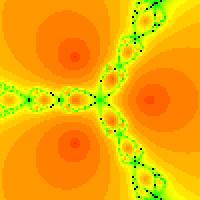
Complex Numbers in this form may be added or subtracted easily by working with the real and imaginary components as separate values. However, to multiply or divide complex numbers requires additional effort. For instance, to raise a + bi to the second power, the following computations must be done:
| ( a + bi )2 |
= ( a + bi ) * ( a + bi ) = a2 + 2abi + b2i2 = a2 + 2abi + b2 * (-1) = a2 - b2 + 2abi |
Division becomes even more difficult since it is not proper to leave a value of i in the denominator of a complex number. For instance, to divide the Complex Number 4 + 3i by the value 2 + i, a number of strange steps must be taken. First, the numerator and denominator must be multiplied the "complex conjugate" of the denominator to get rid of the i in the bottom of the fraction caused by the division process. The complex conjugate has the same basic values for the real and imaginary parts except that the sign is different. For instance, the conjugate of (2 + i) is (2 - i), and by multiplying the top and bottom of the fraction by that same amount is essentially just multiplying by a strange form of the number 1 and does not change the value. However, this process does get rid of the i in the bottom of the fraction and after that the real and imaginary components can be separated. The following example will show the process:
| ( 4 + 3i ) / ( 2 + i ) |
= [(4+3i)/(2+i)] * [(2-i)/(2-i)] = [(4+3i) * (2-i)] / [(2+i) * (2-i)] = [(4+3i)*(2-i) ] / [4 - i2 ] = [(4+3i)*(2-i) ] / [4 + 1] = [(4+3i)*(2-i)] / 5 = [ 8 + 6i - 4i - 3i2] / 5 = [ 8 + 2i + 3] / 5 = [11 + 2i] / 5 = (11/5) + (2/5) i |
The real part is now 11/5 and the imaginary is 2/5.
This may seem rather difficult, but there is a real advantage of this form when working with fractional powers. There is a famous rule called DeMoivre's Theorem that states that a complex number in polar form can be raised to a power through the following process:
| Zn |
= [r ( cos(theta) + i * sin(theta) )]n = rn * ( cos(n*theta) + i * sin(n*theta) ) |
This form can be very helpful when calculating certain powers for complex numbers since the real component is rn * cos(n*theta) and the imaginary part is rn * sin(n*theta) even if n is some strange fractional exponent.